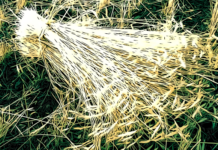Ancient grains in the limelight, gluten free pulling more than a ship’s elbow, superfoods at the center of European consumer demands. Three aces for Teff, a cereal to be discovered.
Teff, grain of Africa
Teff (
Eragrostis
tef
) is a cereal in the Gramineae family, native to the ancient civilization of Abyssinia (Ethiopia) where it has been cultivated since 4,000 B.C. It is also widespread in Eritrea and India, as well as in Spain, and is beginning to emerge in the food production of the United States and Australia.
The name Teff-from the ethio-Semitic root ‘tff,’ meaning ‘lost’-derives from the ease of dispersal of this cereal’s microscopic seeds. The Teff grain is in fact one of the smallest grains known, with a diameter of just 0.8 mm. Roughly the size of a poppy seed. This characteristic encourages its planting by even the poorest populations, as only a few handfuls of seeds are needed to grow an entire field. (1)
Three varieties of Teff are identified in nature, based on seed coloration. White, red and brown. The lighter variety is the most valuable and is characterized by its delicate flavor. In contrast, the brown and red varieties are characterized by a more intense flavor, vaguely reminiscent of hazelnuts.
Teff, vegan superfood
Protein e dietary fiber. The minimal size of the African grain prevents separation of the germ from the bran (the outer layer of the grain). Teff flour is therefore, playfully, always whole wheat. With a high fiber content but also a considerable protein content, with 8 of the essential amino acids. And it is therefore an ideal food for vegan nutrition as well.
Micronutrients. This tiny seed is a treasure chest of micronutrients, such as calcium and iron, (2) magnesium, phosphorus, potassium, manganese, and zinc. As well as some B vitamins (B1, B2, B3, B9).
Source: Baye, Kaleab. Center for Food Science and Nutrition, College of Natural Science, Addis Ababa University (2014). ‘Teff: Nutrient Composition and Health Benefits’
Teff, food and non-food uses
Ethiopian and Eritrean populations draw two-thirds of their protein ration from Teff (FAO data). Its fermented flour is used to makeenjera, a spongy pancake traditionally served with lentils, vegetables and other foods. It is then used in porridge, a breakfast soup that in Anglo-Saxon countries is made with oats instead. And a local beer, t’ella o fersso, is also brewed there.
Since the tiny seeds are the only portion used for human food, the remaining parts of the herbaceous vegetable are used as feed. And it is also for this purpose cultivated in South Africa and Kenya. Stems are also used in green building–of necessity, virtue–to reinforce rural mud huts.
Crea’s cereal quality center has experimented with growing red and white Ethiopian Teff in Italy. Cultivation was successful, with a three-month production cycle, but harvesting was difficult due to high threshing losses. Some Italian food industries, meanwhile, have begun experimenting with the use of imported flour on baked goods, cereals and bars.
Teff is credited with high growth potential in food production, particularly in the bakery sector. (3) Due in part to the natural absence of gluten and the characteristics of its starch (resistant starch), which lead to the belief that it can lead to a lower glycemic index than other gluten-free grains such as corn and rice.
Laura Pontassuglia and Dario Dongo
Notes
(1) Nevertheless-according to a 2015 report to the BBC by Dr. Zerihun Tadele, project leader at theInstitute of Plant Sciences, University of Bern-yield per hectare in Ethiopia is still low (1.4 t), relative to the global average for modern wheat varieties (3.2 t). The African cereal, after all, has so far received little consideration from agronomy research
(2) Intake levels of iron contributed by teff foods (bread) have been favorably evaluated in a couple of studies:
– Alaunyte, I., Stojceska, V., Derbyshire, E., Plunkett, A., & Ainsworth, P. (2010). ‘Iron-rich Teff-grain bread: An opportunity to improve individual’s iron status‘. Proceedings of the Nutrition Society, 69 (OCE1), E105. doi:10.1017/S002966510999293X
– Bokhari, F & Derbyshire, Emma & Li, Weili & Brennan, Charles & Stojceska, V. (2011). ‘A study to establish whether food-based approaches can improve serum iron levels in child-bearing aged women‘. Journal of human nutrition and dietetics: the official journal of the British Dietetic Association. 25. 95-100. doi: 10.1111/j.1365-277X.2011.01185.x.
(3) See M.J. Callejo and M. Rodrìguez Quijano (2015). ‘Influence of teff variety and wheat flour strength on breadmaking properties of healthier teff-based breads‘.Journal of Cereal Science, 68. doi: 10.1016/j.jcs.2015.11.005









